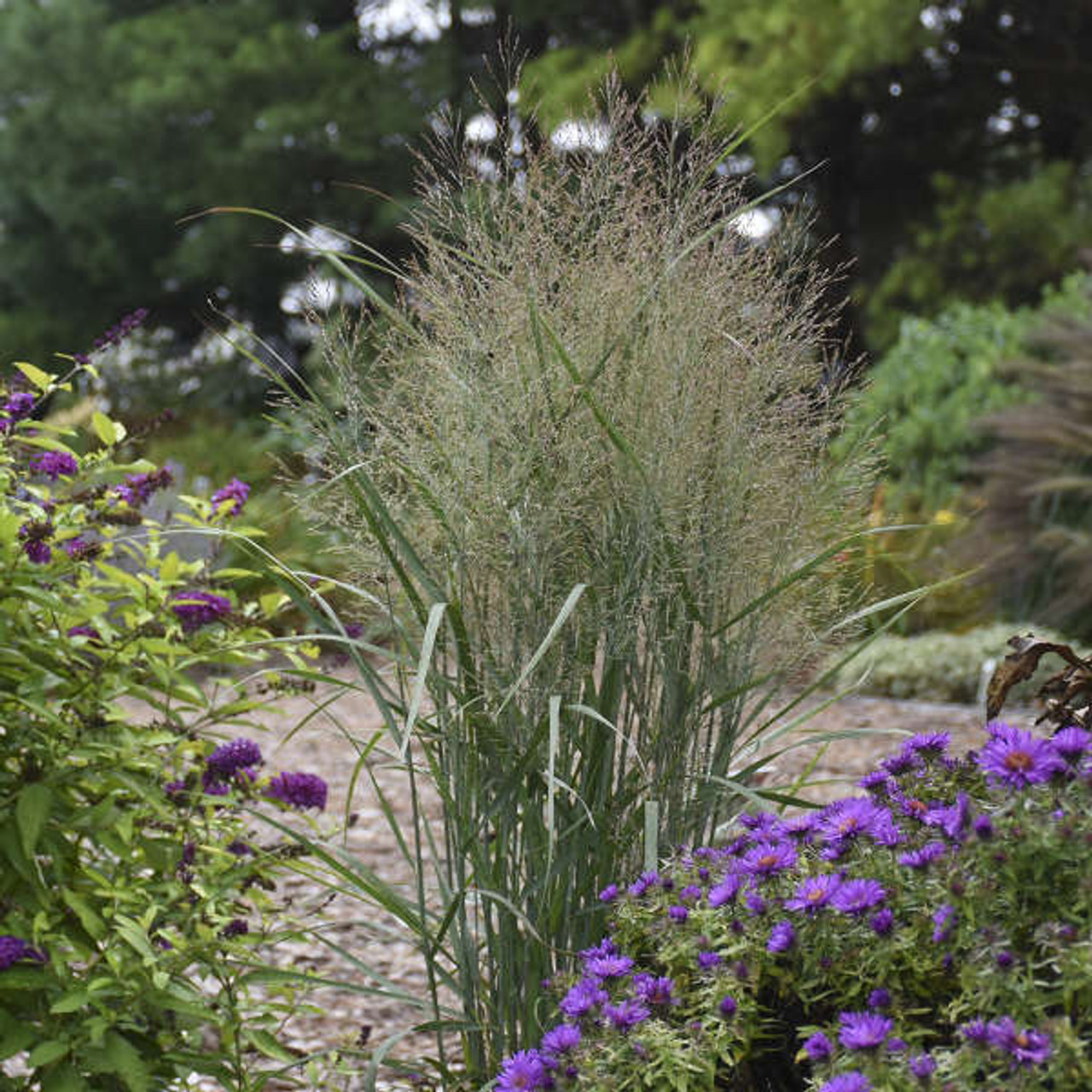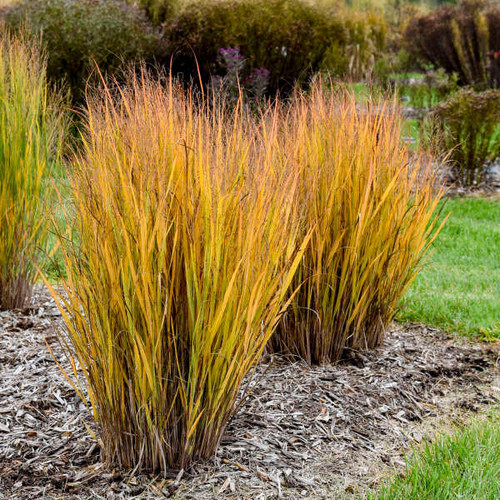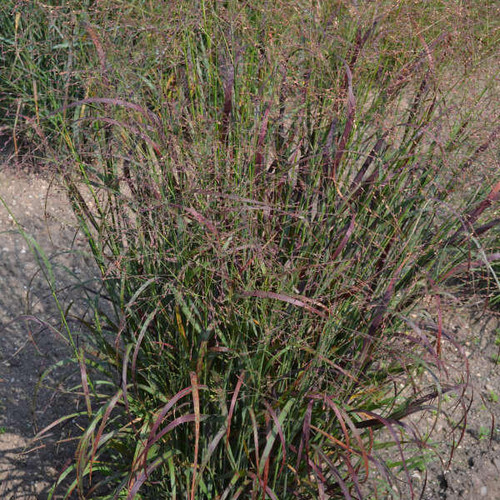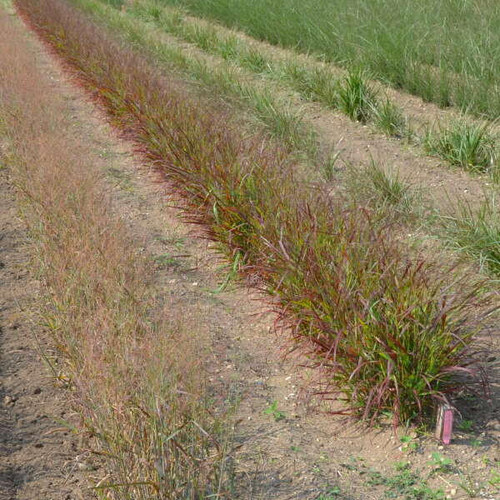Product Description
Panicum v. 'Gunsmoke' PPAF (30)ct Flat
Common Name: Switch Grass, Ornamental Grass
A new nativar perfect for the late summer landscape! The seedheads on this moderately sized grass billow over the top of the habit. Wide, steel colored leaves densely pack the robust habit. It is closest in size to 'Apache Rose', but differs with tan seedheads and a wider habit.
Height: 4.0-4.5 Feet
Spread: 3.0-3.5 Feet
Hardiness Zones: 4,5,6,7,8,9
Foliage Color: Green shades / Blue shades
Full Sun (> 6 hrs. Direct Sun)
Low to Average Water Needs
Consistent Water Needs
Poor to Fertile Soil Quality
Bloomtime: Late Summer
Deer Resistant
Growth Rate: Medium
Border Plant, Container, Cut Flower, Cut Foliage, Dried Flower, Drought Tolerant, Easy To Grow, Mass Planting, Salt Tolerant, Focal Point
Panicum virgatum 'Gunsmoke', commonly known as switchgrass, is a warm-season ornamental grass prized for its striking blue-gray foliage and airy texture. This North American native grass brings a unique smoky hue to gardens and landscapes, making it a popular choice for adding vertical interest and movement.
'Gunsmoke' switchgrass is a clump-forming grass with an upright growth habit. It typically reaches a height of 3 to 4 feet with a similar spread, but when mature, it reaches 6 to 8 inches tall and wide. The foliage emerges with a bluish-green tint in spring, gradually deepening to a stunning blue-gray as the season progresses. This unique color transformation adds depth and visual interest to the garden throughout the growing season. In late spring through early summer, the plant produces delicate flower panicles that rise above the foliage, adding to its airy appearance. These panicles mature to a tan color, providing visual interest well into the fall and winter months.
Care Requirements 'Gunsmoke' switchgrass is a low-maintenance and adaptable plant that thrives in a variety of conditions. It is hardy in USDA zones 4a, 4b, 5a, 5b, 6a, 6b, 7a, 7b, 8a, 8b, 9a, and 9b. Here are some key care requirements:
- Sunlight: Plant 'Gunsmoke' in full sun for optimal growth and color development. It can tolerate some shade, but the foliage may not be as vibrant.
- Soil: This grass adapts to a wide range of soil types, but it prefers well-drained soil.
- Water: Water regularly during the first growing season to establish a deep root system. Once established, 'Gunsmoke' is relatively drought tolerant.
- Fertilizer: This grass is not a heavy feeder. An application of a balanced fertilizer in spring is usually sufficient.
- Pruning: Cut back the foliage to about 6 inches in late winter or early spring before new growth emerges.
Uses 'Gunsmoke' switchgrass is a versatile plant with many uses in the landscape. Here are a few ideas:
- Borders and Edging: Use 'Gunsmoke' to create a soft and textured border along walkways or garden beds.
- Mass Plantings: Plant in groups to create a dramatic and eye-catching display.
- Meadow Plantings: Combine with other grasses and perennials to create a naturalistic meadow effect.
- Erosion Control: Its deep root system makes it an excellent choice for stabilizing slopes and preventing erosion.
- Wildlife Habitat: 'Gunsmoke' provides shelter and nesting sites for birds and other small wildlife.
Companion Plants 'Gunsmoke' switchgrass pairs well with a variety of plants. Consider combining it with:
- Echinacea (Coneflower): Both plants attract pollinators and have similar growing requirements. They create a vibrant display when planted together, with the purple coneflower blooms contrasting beautifully with the blue-gray foliage of 'Gunsmoke'.
- Rudbeckia (Black-eyed Susan): These plants provide a contrasting color and texture. The bright golden-yellow flowers of Rudbeckia create a cheerful contrast against the cool tones of 'Gunsmoke'.
- Monarda (Bee Balm): Both plants attract hummingbirds and butterflies. Planting 'Gunsmoke' and Monarda together creates a pollinator paradise, with their vibrant colors and nectar-rich blooms attracting a variety of beneficial insects.
- Lavender: The fragrant foliage of both plants can help deter pests. The combination of 'Gunsmoke' and lavender creates a sensory delight, with the soft textures and colors complemented by the soothing fragrance of lavender.
- Geranium 'Rozanne'
- Helictotrichon sempervirens (Blue Oat Grass)
- Salvia 'Crystal Blue'
- Spigelia 'Little Redhead' (Indian Pink)
- Veronica 'Blue Skywalker' (Speedwell)
Panicum virgatum 'Gunsmoke' is an excellent choice for adding beauty and texture to any landscape. Its striking blue-gray foliage, airy texture, and low-maintenance nature make it a favorite among gardeners. Whether used in borders, mass plantings, or meadow gardens, 'Gunsmoke' switchgrass is sure to make a statement. This adaptable and visually stunning grass not only enhances the aesthetic appeal of a garden but also provides ecological benefits by attracting pollinators and providing habitat for wildlife. Its versatility and resilience make it a valuable addition to any landscape design.
Thirty (30) plants per flat (or tray). Approximate Plug Measurements: 4.25 inches deep x 2 inches wide.
Other Details
The most important part of the plant is its root system. Healthy roots are the foundation of a healthy, vibrant plant. The type of plug container used is based on the specific needs of the plants. Perennials offered as bare root traditionally perform better when planted as bare root.Planted in a specialized mix, potted plants have well established root systems. Top growth stage will vary depending on the current life cycle and time of year when shipped. In Winter and early Spring dormant plants may be shipped. Dormant plants may be planted right away, even before the last frost date.
Most bare root varieties are field grown for at least one season, though Hemerocallis and Hosta are grown for two seasons. The bulk of the soil is removed during the harvesting process and the tops of most varieties are trimmed back to the crown. They are graded, packed in shredded aspen or sphagnum moss and stored in freezers until ready to be shipped.
See our Container Sizes and Bare Root Perennials pages for more information.
Plant information and care is provided in the Overview section, Plant Genus Page and general information is provided in the Planting Care & Guides. Additional questions can be asked on each Plant page.
Plant Spacing: Using the maximum mature spread or width of a plant to guide spacing, ensures space to grow to full size. To fill an area sooner, plant them closer together. Just remember, future thinning or transplanting may be needed.
Water: Keep a close eye on newly planted perennials, especially throughout the first growing year. Most early plant loss is due to too much or too little water!















